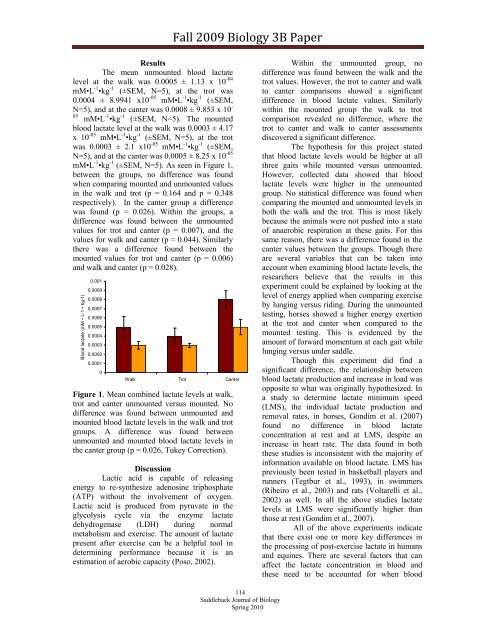Saddleback Journal of Biology - Saddleback College
Saddleback Journal of Biology - Saddleback College
Saddleback Journal of Biology - Saddleback College
You also want an ePaper? Increase the reach of your titles
YUMPU automatically turns print PDFs into web optimized ePapers that Google loves.
Fall 2009 <strong>Biology</strong> 3B Paper<br />
Results<br />
The mean unmounted blood lactate<br />
level at the walk was 0.0005 ± 1.13 x 10 -04<br />
mM•L -1 •kg -1 (±SEM, N=5), at the trot was<br />
0.0004 ± 8.9941 x10 -05 mM•L -1 •kg -1 (±SEM,<br />
N=5), and at the canter was 0.0008 ± 9.853 x 10 -<br />
05<br />
mM•L -1 •kg -1 (±SEM, N=5). The mounted<br />
blood lactate level at the walk was 0.0003 ± 4.17<br />
x 10 -05 mM•L -1 •kg -1 (±SEM, N=5), at the trot<br />
was 0.0003 ± 2.1 x10 -05 mM•L -1 •kg -1 (±SEM,<br />
N=5), and at the canter was 0.0005 ± 8.25 x 10 -05<br />
mM•L -1 •kg -1 (±SEM, N=5). As seen in Figure 1,<br />
between the groups, no difference was found<br />
when comparing mounted and unmounted values<br />
in the walk and trot (p = 0.164 and p = 0.348<br />
respectively). In the canter group a difference<br />
was found (p = 0.026). Within the groups, a<br />
difference was found between the unmounted<br />
values for trot and canter (p = 0.007), and the<br />
values for walk and canter (p = 0.044). Similarly<br />
there was a difference found between the<br />
mounted values for trot and canter (p = 0.006)<br />
and walk and canter (p = 0.028).<br />
Blood lactate (mM • L-1 • kg-1)<br />
0.001<br />
0.0009<br />
0.0008<br />
0.0007<br />
0.0006<br />
0.0005<br />
0.0004<br />
0.0003<br />
0.0002<br />
0.0001<br />
0<br />
Walk Trot Canter<br />
Figure 1. Mean combined lactate levels at walk,<br />
trot and canter unmounted versus mounted. No<br />
difference was found between unmounted and<br />
mounted blood lactate levels in the walk and trot<br />
groups. A difference was found between<br />
unmounted and mounted blood lactate levels in<br />
the canter group (p = 0.026, Tukey Correction).<br />
Discussion<br />
Lactic acid is capable <strong>of</strong> releasing<br />
energy to re-synthesize adenosine triphosphate<br />
(ATP) without the involvement <strong>of</strong> oxygen.<br />
Lactic acid is produced from pyruvate in the<br />
glycolysis cycle via the enzyme lactate<br />
dehydrogenase (LDH) during normal<br />
metabolism and exercise. The amount <strong>of</strong> lactate<br />
present after exercise can be a helpful tool in<br />
determining performance because it is an<br />
estimation <strong>of</strong> aerobic capacity (Poso, 2002).<br />
Within the unmounted group, no<br />
difference was found between the walk and the<br />
trot values. However, the trot to canter and walk<br />
to canter comparisons showed a significant<br />
difference in blood lactate values. Similarly<br />
within the mounted group the walk to trot<br />
comparison revealed no difference, where the<br />
trot to canter and walk to canter assessments<br />
discovered a significant difference.<br />
The hypothesis for this project stated<br />
that blood lactate levels would be higher at all<br />
three gaits while mounted versus unmounted.<br />
However, collected data showed that blood<br />
lactate levels were higher in the unmounted<br />
group. No statistical difference was found when<br />
comparing the mounted and unmounted levels in<br />
both the walk and the trot. This is most likely<br />
because the animals were not pushed into a state<br />
<strong>of</strong> anaerobic respiration at these gaits. For this<br />
same reason, there was a difference found in the<br />
canter values between the groups. Though there<br />
are several variables that can be taken into<br />
account when examining blood lactate levels, the<br />
researchers believe that the results in this<br />
experiment could be explained by looking at the<br />
level <strong>of</strong> energy applied when comparing exercise<br />
by lunging versus riding. During the unmounted<br />
testing, horses showed a higher energy exertion<br />
at the trot and canter when compared to the<br />
mounted testing. This is evidenced by the<br />
amount <strong>of</strong> forward momentum at each gait while<br />
lunging versus under saddle.<br />
Though this experiment did find a<br />
significant difference, the relationship between<br />
blood lactate production and increase in load was<br />
opposite to what was originally hypothesized. In<br />
a study to determine lactate minimum speed<br />
(LMS), the individual lactate production and<br />
removal rates, in horses, Gondim et al. (2007)<br />
found no difference in blood lactate<br />
concentration at rest and at LMS, despite an<br />
increase in heart rate. The data found in both<br />
these studies is inconsistent with the majority <strong>of</strong><br />
information available on blood lactate. LMS has<br />
previously been tested in basketball players and<br />
runners (Tegtbur et al., 1993), in swimmers<br />
(Ribeiro et al., 2003) and rats (Voltarelli et al.,<br />
2002) as well. In all the above studies lactate<br />
levels at LMS were significantly higher than<br />
those at rest (Gondim et al., 2007).<br />
All <strong>of</strong> the above experiments indicate<br />
that there exist one or more key differences in<br />
the processing <strong>of</strong> post-exercise lactate in humans<br />
and equines. There are several factors that can<br />
affect the lactate concentration in blood and<br />
these need to be accounted for when blood<br />
114<br />
<strong>Saddleback</strong> <strong>Journal</strong> <strong>of</strong> <strong>Biology</strong><br />
Spring 2010

















